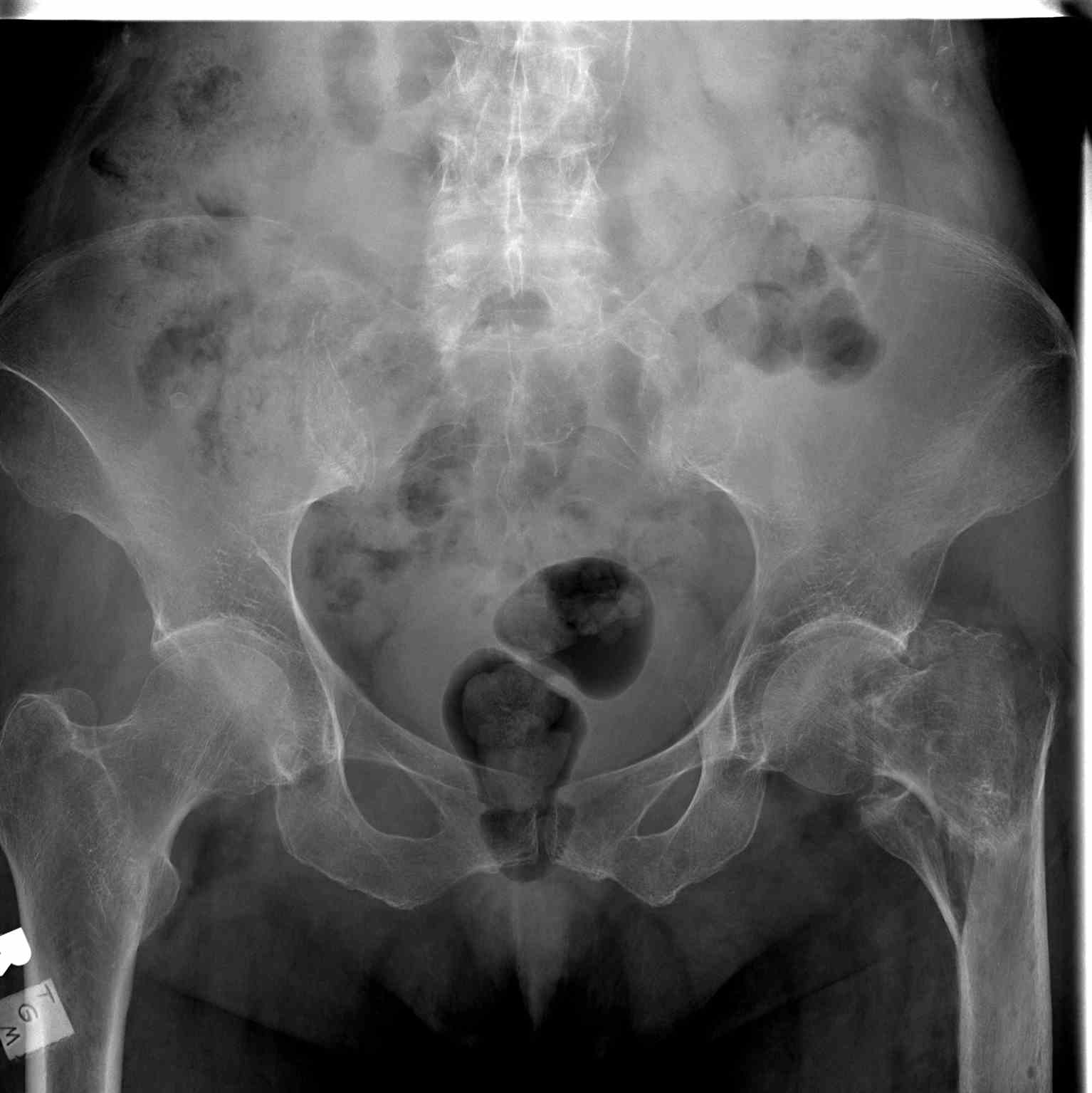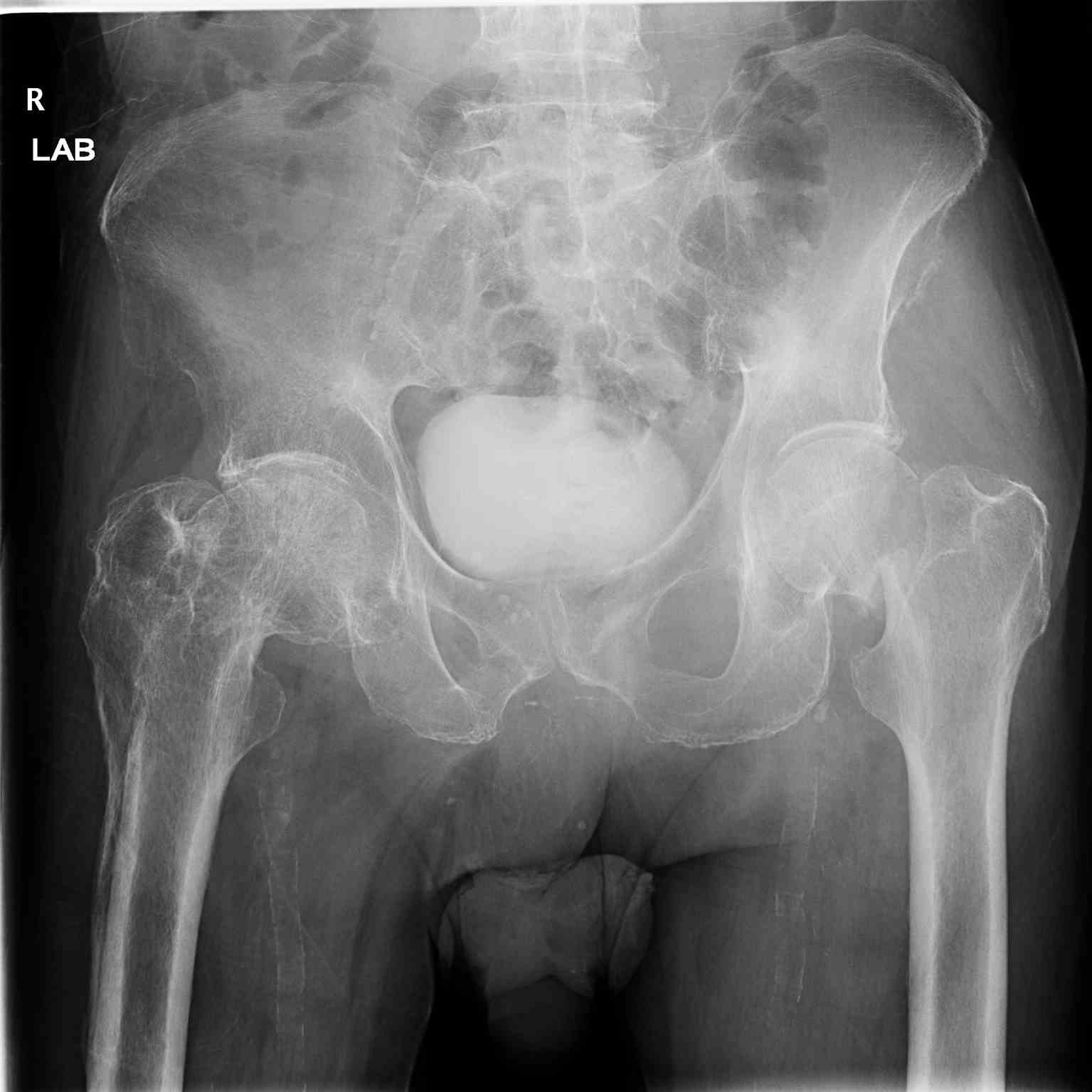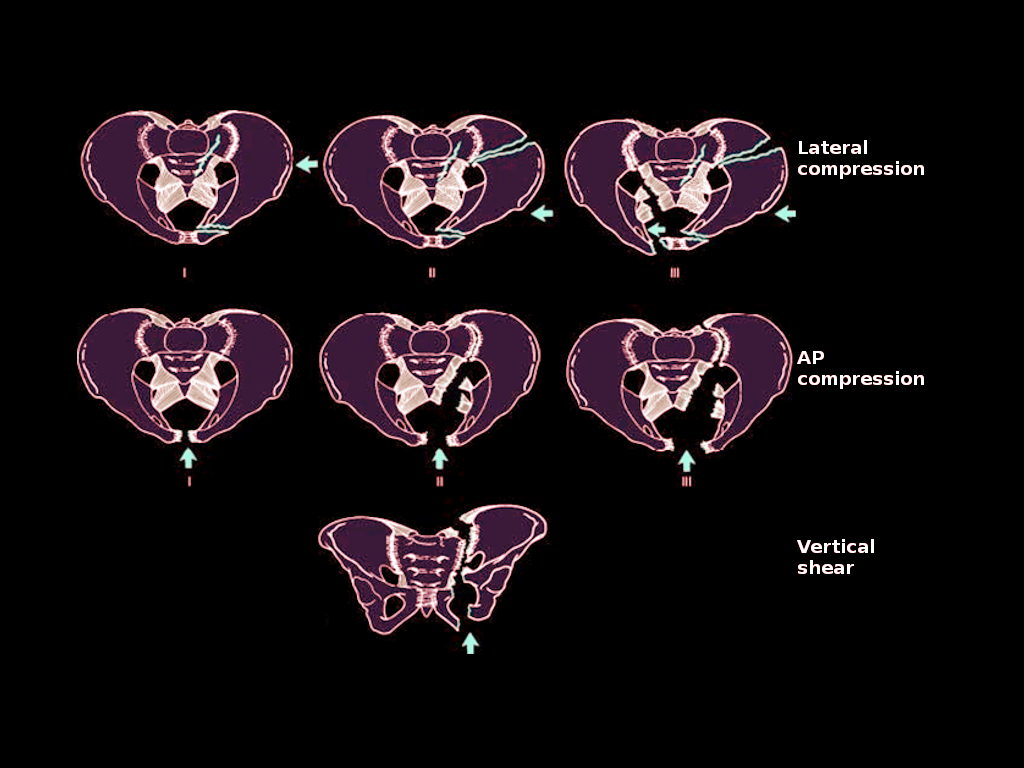[1]
Mackenzie EJ, Rivara FP, Jurkovich GJ, Nathens AB, Frey KP, Egleston BL, Salkever DS, Weir S, Scharfstein DO. The National Study on Costs and Outcomes of Trauma. The Journal of trauma. 2007 Dec:63(6 Suppl):S54-67; discussion S81-6
[PubMed PMID: 18091213]
[2]
Wijffels DJ, Verbeek DO, Ponsen KJ, Carel Goslings J, van Delden OM. Imaging and Endovascular Treatment of Bleeding Pelvic Fractures: Review Article. Cardiovascular and interventional radiology. 2019 Jan:42(1):10-18. doi: 10.1007/s00270-018-2071-4. Epub 2018 Sep 17
[PubMed PMID: 30225676]
[3]
Chiodo A. Neurologic injury associated with pelvic trauma: radiology and electrodiagnosis evaluation and their relationships to pain and gait outcome. Archives of physical medicine and rehabilitation. 2007 Sep:88(9):1171-6
[PubMed PMID: 17826464]
[4]
Coccolini F, Stahel PF, Montori G, Biffl W, Horer TM, Catena F, Kluger Y, Moore EE, Peitzman AB, Ivatury R, Coimbra R, Fraga GP, Pereira B, Rizoli S, Kirkpatrick A, Leppaniemi A, Manfredi R, Magnone S, Chiara O, Solaini L, Ceresoli M, Allievi N, Arvieux C, Velmahos G, Balogh Z, Naidoo N, Weber D, Abu-Zidan F, Sartelli M, Ansaloni L. Pelvic trauma: WSES classification and guidelines. World journal of emergency surgery : WJES. 2017:12():5. doi: 10.1186/s13017-017-0117-6. Epub 2017 Jan 18
[PubMed PMID: 28115984]
[5]
Rossaint R, Bouillon B, Cerny V, Coats TJ, Duranteau J, Fernández-Mondéjar E, Hunt BJ, Komadina R, Nardi G, Neugebauer E, Ozier Y, Riddez L, Schultz A, Stahel PF, Vincent JL, Spahn DR, Task Force for Advanced Bleeding Care in Trauma. Management of bleeding following major trauma: an updated European guideline. Critical care (London, England). 2010:14(2):R52. doi: 10.1186/cc8943. Epub 2010 Apr 6
[PubMed PMID: 20370902]
[6]
Demetriades D, Karaiskakis M, Toutouzas K, Alo K, Velmahos G, Chan L. Pelvic fractures: epidemiology and predictors of associated abdominal injuries and outcomes. Journal of the American College of Surgeons. 2002 Jul:195(1):1-10
[PubMed PMID: 12113532]
[7]
Zhang F,Liao L, Artificial urinary sphincter implantation: an important component of complex surgery for urinary tract reconstruction in patients with refractory urinary incontinence. BMC urology. 2018 Jan 8
[PubMed PMID: 29310634]
[8]
Giannoudis PV, Grotz MR, Tzioupis C, Dinopoulos H, Wells GE, Bouamra O, Lecky F. Prevalence of pelvic fractures, associated injuries, and mortality: the United Kingdom perspective. The Journal of trauma. 2007 Oct:63(4):875-83
[PubMed PMID: 18090020]
Level 3 (low-level) evidence
[9]
Li P, Zhou D, Fu B, Song W, Dong J. Management and outcome of pelvic fracture associated with vaginal injuries: a retrospective study of 25 cases. BMC musculoskeletal disorders. 2019 Oct 22:20(1):466. doi: 10.1186/s12891-019-2839-y. Epub 2019 Oct 22
[PubMed PMID: 31640643]
Level 2 (mid-level) evidence
[10]
Siegmeth A, Müllner T, Kukla C, Vécsei V. [Associated injuries in severe pelvic trauma]. Der Unfallchirurg. 2000 Jul:103(7):572-81
[PubMed PMID: 10969545]
[11]
Pereira SJ,O'Brien DP,Luchette FA,Choe KA,Lim E,Davis K Jr,Hurst JM,Johannigman JA,Frame SB, Dynamic helical computed tomography scan accurately detects hemorrhage in patients with pelvic fracture. Surgery. 2000 Oct;
[PubMed PMID: 11015102]
[12]
Grotz MR, Allami MK, Harwood P, Pape HC, Krettek C, Giannoudis PV. Open pelvic fractures: epidemiology, current concepts of management and outcome. Injury. 2005 Jan:36(1):1-13
[PubMed PMID: 15589906]
[13]
Blackmore CC, Cummings P, Jurkovich GJ, Linnau KF, Hoffer EK, Rivara FP. Predicting major hemorrhage in patients with pelvic fracture. The Journal of trauma. 2006 Aug:61(2):346-52
[PubMed PMID: 16917449]
[14]
Alton TB, Gee AO. Classifications in brief: young and burgess classification of pelvic ring injuries. Clinical orthopaedics and related research. 2014 Aug:472(8):2338-42. doi: 10.1007/s11999-014-3693-8. Epub 2014 May 28
[PubMed PMID: 24867452]
[15]
Young JW, Burgess AR, Brumback RJ, Poka A. Pelvic fractures: value of plain radiography in early assessment and management. Radiology. 1986 Aug:160(2):445-51
[PubMed PMID: 3726125]
[16]
Shlamovitz GZ, Mower WR, Bergman J, Chuang KR, Crisp J, Hardy D, Sargent M, Shroff SD, Snyder E, Morgan MT. How (un)useful is the pelvic ring stability examination in diagnosing mechanically unstable pelvic fractures in blunt trauma patients? The Journal of trauma. 2009 Mar:66(3):815-20. doi: 10.1097/TA.0b013e31817c96e1. Epub
[PubMed PMID: 19276759]
[17]
Coughenour J. Initial Evaluation and Management of the Injured Patient. Missouri medicine. 2018 Sep-Oct:115(5):429-433
[PubMed PMID: 30385990]
[18]
Ingram MD, Watson SG, Skippage PL, Patel U. Urethral injuries after pelvic trauma: evaluation with urethrography. Radiographics : a review publication of the Radiological Society of North America, Inc. 2008 Oct:28(6):1631-43. doi: 10.1148/rg.286085501. Epub
[PubMed PMID: 18936026]
[19]
Geeraerts T, Chhor V, Cheisson G, Martin L, Bessoud B, Ozanne A, Duranteau J. Clinical review: initial management of blunt pelvic trauma patients with haemodynamic instability. Critical care (London, England). 2007:11(1):204
[PubMed PMID: 17300738]
[20]
Gonzalez E, Moore EE, Moore HB. Management of Trauma-Induced Coagulopathy with Thrombelastography. Critical care clinics. 2017 Jan:33(1):119-134. doi: 10.1016/j.ccc.2016.09.002. Epub
[PubMed PMID: 27894492]
[21]
Friese RS, Malekzadeh S, Shafi S, Gentilello LM, Starr A. Abdominal ultrasound is an unreliable modality for the detection of hemoperitoneum in patients with pelvic fracture. The Journal of trauma. 2007 Jul:63(1):97-102
[PubMed PMID: 17622875]
[22]
Guillamondegui OD, Pryor JP, Gracias VH, Gupta R, Reilly PM, Schwab CW. Pelvic radiography in blunt trauma resuscitation: a diminishing role. The Journal of trauma. 2002 Dec:53(6):1043-7
[PubMed PMID: 12478025]
[23]
Verbeek DO, Burgess AR. Importance of Pelvic Radiography for Initial Trauma Assessment: An Orthopedic Perspective. The Journal of emergency medicine. 2016 Jun:50(6):852-8. doi: 10.1016/j.jemermed.2015.03.048. Epub 2016 Apr 25
[PubMed PMID: 27133737]
Level 3 (low-level) evidence
[24]
Barratt RC, Bernard J, Mundy AR, Greenwell TJ. Pelvic fracture urethral injury in males-mechanisms of injury, management options and outcomes. Translational andrology and urology. 2018 Mar:7(Suppl 1):S29-S62. doi: 10.21037/tau.2017.12.35. Epub
[PubMed PMID: 29644168]
[25]
Dixon AN, Webb JC, Wenzel JL, Wolf JS Jr, Osterberg EC. Current management of pelvic fracture urethral injuries: to realign or not? Translational andrology and urology. 2018 Aug:7(4):593-602. doi: 10.21037/tau.2018.01.14. Epub
[PubMed PMID: 30211049]
[26]
Ben-Menachem Y,Coldwell DM,Young JW,Burgess AR, Hemorrhage associated with pelvic fractures: causes, diagnosis, and emergent management. AJR. American journal of roentgenology. 1991 Nov;
[PubMed PMID: 1927786]
[27]
Agri F, Bourgeat M, Becce F, Moerenhout K, Pasquier M, Borens O, Yersin B, Demartines N, Zingg T. Association of pelvic fracture patterns, pelvic binder use and arterial angio-embolization with transfusion requirements and mortality rates; a 7-year retrospective cohort study. BMC surgery. 2017 Nov 9:17(1):104. doi: 10.1186/s12893-017-0299-6. Epub 2017 Nov 9
[PubMed PMID: 29121893]
Level 2 (mid-level) evidence
[28]
Chou CH, Wu YT, Fu CY, Liao CH, Wang SY, Bajani F, Hsieh CH. Hemostasis as soon as possible? The role of the time to angioembolization in the management of pelvic fracture. World journal of emergency surgery : WJES. 2019:14():28. doi: 10.1186/s13017-019-0248-z. Epub 2019 Jun 13
[PubMed PMID: 31210779]
[29]
Broadwell SR, Ray CE. Transcatheter embolization in pelvic trauma. Seminars in interventional radiology. 2004 Mar:21(1):23-35. doi: 10.1055/s-2004-831402. Epub
[PubMed PMID: 21331106]
[30]
Miller PR,Moore PS,Mansell E,Meredith JW,Chang MC, External fixation or arteriogram in bleeding pelvic fracture: initial therapy guided by markers of arterial hemorrhage. The Journal of trauma. 2003 Mar;
[PubMed PMID: 12634521]
[31]
Balogh Z, Caldwell E, Heetveld M, D'Amours S, Schlaphoff G, Harris I, Sugrue M. Institutional practice guidelines on management of pelvic fracture-related hemodynamic instability: do they make a difference? The Journal of trauma. 2005 Apr:58(4):778-82
[PubMed PMID: 15824655]
Level 1 (high-level) evidence
[32]
Shim H, Jang JY, Kim JW, Ryu H, Jung PY, Kim S, Kwon HY, Kim KM, Chung H, Bae KS. Effectiveness and postoperative wound infection of preperitoneal pelvic packing in patients with hemodynamic instability caused by pelvic fracture. PloS one. 2018:13(11):e0206991. doi: 10.1371/journal.pone.0206991. Epub 2018 Nov 5
[PubMed PMID: 30395596]
[33]
Stannard A, Eliason JL, Rasmussen TE. Resuscitative endovascular balloon occlusion of the aorta (REBOA) as an adjunct for hemorrhagic shock. The Journal of trauma. 2011 Dec:71(6):1869-72. doi: 10.1097/TA.0b013e31823fe90c. Epub
[PubMed PMID: 22182896]
[34]
Jarvis S,Kelly M,Mains C,Corrigan C,Patel N,Carrick M,Lieser M,Banton K,Bar-Or D, A descriptive survey on the use of resuscitative endovascular balloon occlusion of the aorta (REBOA) for pelvic fractures at US level I trauma centers. Patient safety in surgery. 2019
[PubMed PMID: 31857823]
Level 3 (low-level) evidence
[35]
Moore LJ, Martin CD, Harvin JA, Wade CE, Holcomb JB. Resuscitative endovascular balloon occlusion of the aorta for control of noncompressible truncal hemorrhage in the abdomen and pelvis. American journal of surgery. 2016 Dec:212(6):1222-1230. doi: 10.1016/j.amjsurg.2016.09.027. Epub 2016 Sep 30
[PubMed PMID: 28340927]
[36]
Ribeiro Junior MAF, Feng CYD, Nguyen ATM, Rodrigues VC, Bechara GEK, de-Moura RR, Brenner M. The complications associated with Resuscitative Endovascular Balloon Occlusion of the Aorta (REBOA). World journal of emergency surgery : WJES. 2018:13():20. doi: 10.1186/s13017-018-0181-6. Epub 2018 May 11
[PubMed PMID: 29774048]
[37]
Gamberini E, Coccolini F, Tamagnini B, Martino C, Albarello V, Benni M, Bisulli M, Fabbri N, Hörer TM, Ansaloni L, Coniglio C, Barozzi M, Agnoletti V. Resuscitative Endovascular Balloon Occlusion of the Aorta in trauma: a systematic review of the literature. World journal of emergency surgery : WJES. 2017:12():42. doi: 10.1186/s13017-017-0153-2. Epub 2017 Aug 29
[PubMed PMID: 28855960]
Level 1 (high-level) evidence
[38]
Halawi MJ, Pelvic ring injuries: Surgical management and long-term outcomes. Journal of clinical orthopaedics and trauma. 2016 Jan-Mar;
[PubMed PMID: 26908968]
[39]
Calafi LA, Routt ML. Anterior pelvic external fixation: is there an optimal placement for the supra-acetabular pin? American journal of orthopedics (Belle Mead, N.J.). 2013 Dec:42(12):E125-7
[PubMed PMID: 24471155]
[40]
Lee C, Sciadini M. The Use of External Fixation for the Management of the Unstable Anterior Pelvic Ring. Journal of orthopaedic trauma. 2018 Sep:32 Suppl 6():S14-S17. doi: 10.1097/BOT.0000000000001251. Epub
[PubMed PMID: 30095676]
[41]
Gordon WT, Fleming ME, Johnson AE, Gurney J, Shackelford S, Stockinger ZT. Pelvic Fracture Care. Military medicine. 2018 Sep 1:183(suppl_2):115-117. doi: 10.1093/milmed/usy111. Epub
[PubMed PMID: 30189052]
[42]
Pape HC, Griensven MV, Hildebrand FF, Tzioupis CT, Sommer KL, Krettek CC, Giannoudis PV, Epoff Study group. Systemic inflammatory response after extremity or truncal fracture operations. The Journal of trauma. 2008 Dec:65(6):1379-84. doi: 10.1097/TA.0b013e31818c8e8c. Epub
[PubMed PMID: 19077630]
[43]
Hak DJ, Baran S, Stahel P. Sacral fractures: current strategies in diagnosis and management. Orthopedics. 2009 Oct:32(10):. pii: orthosupersite.com/view.asp?rID=44034. doi: 10.3928/01477447-20090818-18. Epub
[PubMed PMID: 19824583]
[44]
Langford JR, Burgess AR, Liporace FA, Haidukewych GJ. Pelvic fractures: part 2. Contemporary indications and techniques for definitive surgical management. The Journal of the American Academy of Orthopaedic Surgeons. 2013 Aug:21(8):458-68. doi: 10.5435/JAAOS-21-08-458. Epub
[PubMed PMID: 23908252]
[45]
Mehta S, Auerbach JD, Born CT, Chin KR. Sacral fractures. The Journal of the American Academy of Orthopaedic Surgeons. 2006 Nov:14(12):656-65
[PubMed PMID: 17077338]
[46]
Inaba K, McKenney M, Munera F, de Moya M, Lopez PP, Schulman CI, Habib FA. Cystogram follow-up in the management of traumatic bladder disruption. The Journal of trauma. 2006 Jan:60(1):23-8
[PubMed PMID: 16456432]
[47]
Chung PH, Wessells H, Voelzke BB. Updated Outcomes of Early Endoscopic Realignment for Pelvic Fracture Urethral Injuries at a Level 1 Trauma Center. Urology. 2018 Feb:112():191-197. doi: 10.1016/j.urology.2017.09.032. Epub 2017 Oct 25
[PubMed PMID: 29079211]
[49]
Navsaria PH, Edu S, Nicol AJ. Civilian extraperitoneal rectal gunshot wounds: surgical management made simpler. World journal of surgery. 2007 Jun:31(6):1345-51
[PubMed PMID: 17457641]
[50]
Bosarge PL, Como JJ, Fox N, Falck-Ytter Y, Haut ER, Dorion HA, Patel NJ, Rushing A, Raff LA, McDonald AA, Robinson BR, McGwin G Jr, Gonzalez RP. Management of penetrating extraperitoneal rectal injuries: An Eastern Association for the Surgery of Trauma practice management guideline. The journal of trauma and acute care surgery. 2016 Mar:80(3):546-51. doi: 10.1097/TA.0000000000000953. Epub
[PubMed PMID: 26713970]
[51]
Yoshihara H, Yoneoka D. Demographic epidemiology of unstable pelvic fracture in the United States from 2000 to 2009: trends and in-hospital mortality. The journal of trauma and acute care surgery. 2014 Feb:76(2):380-5. doi: 10.1097/TA.0b013e3182ab0cde. Epub
[PubMed PMID: 24398776]
[52]
Vaidya R, Scott AN, Tonnos F, Hudson I, Martin AJ, Sethi A. Patients with pelvic fractures from blunt trauma. What is the cause of mortality and when? American journal of surgery. 2016 Mar:211(3):495-500. doi: 10.1016/j.amjsurg.2015.08.038. Epub 2015 Dec 31
[PubMed PMID: 26781723]
[53]
McDonald C, Firoozabadi R, Routt ML Jr, Kleweno C. Complications Associated With Pelvic External Fixation. Orthopedics. 2017 Nov 1:40(6):e959-e963. doi: 10.3928/01477447-20170918-02. Epub 2017 Sep 22
[PubMed PMID: 28934542]
[54]
Bauer RM, Bastian PJ, Gozzi C, Stief CG. Postprostatectomy incontinence: all about diagnosis and management. European urology. 2009 Feb:55(2):322-33. doi: 10.1016/j.eururo.2008.10.029. Epub 2008 Oct 23
[PubMed PMID: 18963418]
[55]
Bananzadeh A, Hosseini SV, Izadpanah A, Izadi A, Khazraei H, Zamani M, Bahrami F. Outcomes of Implementation of Sacral Nerve Stimulation in Incontinent Patients in Shiraz. Advanced biomedical research. 2019:8():21. doi: 10.4103/abr.abr_202_18. Epub 2019 Mar 20
[PubMed PMID: 31016179]
[56]
Saldana Ruiz N, Kaiser AM. Fecal incontinence - Challenges and solutions. World journal of gastroenterology. 2017 Jan 7:23(1):11-24. doi: 10.3748/wjg.v23.i1.11. Epub
[PubMed PMID: 28104977]



